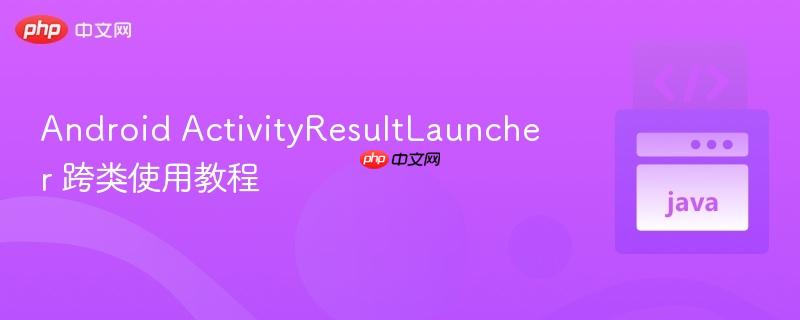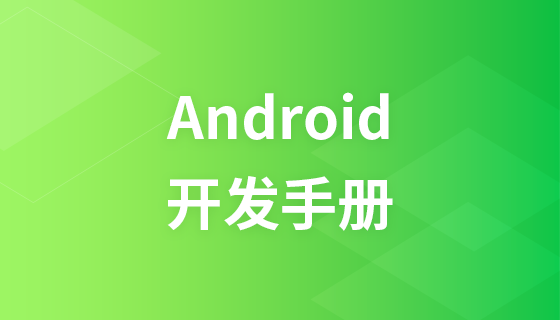
本文详细介绍了在 Android 应用中如何实现 `registerForActivityResult` 的跨类调用。当 `ActivityResultLauncher` 实例在主 Activity 中注册后,若需在其他类中触发其 `launch()` 方法,核心策略是将已注册的 `ActivityResultLauncher` 实例作为参数传递给目标类或方法。文章通过具体代码示例,演示了两种实现方式:构造函数注入和方法参数传递,旨在帮助开发者构建更灵活、解耦的 Android 组件交互逻辑。
registerForActivityResult 是 Android Jetpack 库中用于替代旧版 startActivityForResult() 的现代 API,它提供了一种更安全、更易于管理的方式来处理 Activity 间的结果回调。通常,我们会在 Activity 或 Fragment 的 onCreate() 或 onCreateView() 方法中注册一个 ActivityResultLauncher 实例,并在需要时通过调用其 launch() 方法来启动一个 Activity 并等待结果。然而,当业务逻辑变得复杂,我们需要在 MainActivity 之外的其他辅助类或模块中触发这个 launch() 操作时,如何有效地传递和使用 ActivityResultLauncher 实例就成了一个常见问题。
ActivityResultLauncher 实例在 Activity 或 Fragment 中注册并与宿主的生命周期绑定。它并非一个静态或全局可访问的对象,因此,若要在其他类中调用其 launch() 方法,最直接且推荐的方式就是将这个已注册的实例作为参数,显式地传递给需要使用它的目标类或方法。这符合面向对象编程中的依赖注入原则,有助于保持代码的解耦性和可测试性。
下面将介绍两种主要的实现方式。
这种方法适用于那些需要长期持有 ActivityResultLauncher 实例的辅助类。我们将 ActivityResultLauncher 作为构造函数的参数传递给辅助类,使其能够在自己的方法中调用 launch()。
创建一个辅助类来封装文件选择的逻辑。它将通过构造函数接收 ActivityResultLauncher 实例。
import android.content.Intent;
import androidx.activity.result.ActivityResultLauncher;
import androidx.activity.result.contract.ActivityResultContracts;
/**
* 辅助类,用于封装文件选择逻辑,并利用传入的 ActivityResultLauncher 启动文件选择器。
*/
public class FilePickerHelper {
private final ActivityResultLauncher<Intent> launcher;
/**
* 构造函数,注入 ActivityResultLauncher 实例。
* @param launcher 已注册的 ActivityResultLauncher 实例。
*/
public FilePickerHelper(ActivityResultLauncher<Intent> launcher) {
this.launcher = launcher;
}
/**
* 启动文件选择器以选择图片。
*/
public void pickImageFile() {
Intent intent = new Intent(Intent.ACTION_GET_CONTENT);
intent.setType("image/*"); // 选择所有图片类型
intent.addCategory(Intent.CATEGORY_OPENABLE); // 确保文件可被打开
if (launcher != null) {
launcher.launch(intent);
}
}
/**
* 启动文件选择器以选择指定 MIME 类型的文件。
* @param mimeType 文件的 MIME 类型,例如 "application/pdf", "video/*" 等。
*/
public void pickSpecificFile(String mimeType) {
Intent intent = new Intent(Intent.ACTION_GET_CONTENT);
intent.setType(mimeType);
intent.addCategory(Intent.CATEGORY_OPENABLE);
if (launcher != null) {
launcher.launch(intent);
}
}
}在 MainActivity 中注册 ActivityResultLauncher,然后将其传递给 FilePickerHelper 的实例。
import android.app.Activity;
import android.content.Intent;
import android.net.Uri;
import android.os.Bundle;
import android.widget.Button;
import android.widget.Toast;
import androidx.activity.result.ActivityResult;
import androidx.activity.result.ActivityResultCallback;
import androidx.activity.result.ActivityResultLauncher;
import androidx.activity.result.contract.ActivityResultContracts;
import androidx.appcompat.app.AppCompatActivity;
public class MainActivity extends AppCompatActivity {
private ActivityResultLauncher<Intent> activityResultLauncher;
private FilePickerHelper filePickerHelper;
private String selectedFilePath; // 用于存储选择的文件路径
@Override
protected void onCreate(Bundle savedInstanceState) {
super.onCreate(savedInstanceState);
setContentView(R.layout.activity_main); // 假设您有布局文件 activity_main.xml
// 1. 注册 ActivityResultLauncher
activityResultLauncher = registerForActivityResult(
new ActivityResultContracts.StartActivityForResult(),
new ActivityResultCallback<ActivityResult>() {
@Override
public void onActivityResult(ActivityResult result) {
if (result.getResultCode() == Activity.RESULT_OK) {
if (result.getData() != null) {
Uri uri = result.getData().getData();
if (uri != null) {
// 实际应用中,处理文件路径可能需要更复杂的逻辑,例如使用 ContentResolver
// 这里仅为示例简化处理,可能无法直接获取真实路径
selectedFilePath = uri.getPath();
Toast.makeText(MainActivity.this, "Selected Path: " + selectedFilePath, Toast.LENGTH_LONG).show();
}
}
} else {
Toast.makeText(MainActivity.this, "文件选择已取消", Toast.LENGTH_SHORT).show();
}
}
});
// 2. 实例化 FilePickerHelper,并注入 activityResultLauncher
filePickerHelper = new FilePickerHelper(activityResultLauncher);
// 3. 在按钮点击事件中调用辅助类的方法
Button pickFileButton = findViewById(R.id.pick_file_button); // 假设布局中有一个ID为 pick_file_button 的按钮
if (pickFileButton != null) {
pickFileButton.setOnClickListener(v -> filePickerHelper.pickImageFile());
}
}
}如果辅助类或方法只需要临时使用 ActivityResultLauncher,或者它是一个静态方法,那么将其作为方法的参数传递会更加简洁。
创建一个工具类,包含静态方法,这些方法将 ActivityResultLauncher 作为参数。
import android.content.Intent;
import androidx.activity.result.ActivityResultLauncher;
/**
* 工具类,提供静态方法来启动 ActivityResultLauncher。
*/
public class LauncherUtils {
/**
* 启动文件选择器。
* @param launcher 已注册的 ActivityResultLauncher 实例。
* @param mimeType 文件的 MIME 类型。
*/
public static void launchFilePicker(ActivityResultLauncher<Intent> launcher, String mimeType) {
Intent intent = new Intent(Intent.ACTION_GET_CONTENT);
intent.setType(mimeType);
intent.addCategory(Intent.CATEGORY_OPENABLE);
if (launcher != null) {
launcher.launch(intent);
}
}
/**
* 启动任意 Activity。
* @param launcher 已注册的 ActivityResultLauncher 实例。
* @param intent 待启动的 Intent。
*/
public static void launchActivity(ActivityResultLauncher<Intent> launcher, Intent intent) {
if (launcher != null) {
launcher.launch(intent);
}
}
}// ... MainActivity 的 onCreate 方法中 ...
// 1. 注册 activityResultLauncher (同上文构造函数注入示例)
// ...
// 2. 在按钮点击事件中调用静态工具方法
Button pickPdfButton = findViewById(R.id.pick_pdf_button); // 假设布局中有一个ID为 pick_pdf_button 的按钮
if (pickPdfButton != null) {
pickPdfButton.setOnClickListener(v ->
LauncherUtils.launchFilePicker(activityResultLauncher, "application/pdf")
);
}
// ...生命周期管理: ActivityResultLauncher 是与 Activity 或 Fragment 的生命周期绑定的。确保在 ActivityResultLauncher 活跃的生命周期内调用 launch() 方法。如果 Activity 或 Fragment 已经销毁,调用 launch() 可能会导致崩溃或不期望的行为。
避免内存泄漏: 如果通过构造函数注入的方式将 ActivityResultLauncher 传递给一个生命周期可能长于 Activity 的对象,并且该对象强引用了 ActivityResultLauncher(进而强引用了 Activity),则可能导致内存泄漏。确保辅助类在不再需要时释放对 ActivityResultLauncher 的引用,或者其生命周期与 Activity 保持一致。
接口抽象: 为了进一步解耦和提高可测试性,可以定义一个接口,让辅助类依赖于这个接口而不是具体的 ActivityResultLauncher 实现。这样,在测试时可以轻松地使用模拟对象替换真实实现。
public interface FilePicker {
void pickFile(String mimeType);
}
// 实现类
public class RealFilePicker implements FilePicker {
private final ActivityResultLauncher<Intent> launcher;
public RealFilePicker(ActivityResultLauncher<Intent> launcher) { this.launcher = launcher; }
@Override
public void pickFile(String mimeType) {
Intent intent = new Intent(Intent.ACTION_GET_CONTENT);
intent.setType(mimeType);
intent.addCategory(Intent.CATEGORY_OPENABLE);
if (launcher != null) {
launcher.launch(intent);
}
}
}
// 在 MainActivity 中
// FilePicker filePicker = new RealFilePicker(activityResultLauncher);
// filePicker.pickFile("image/*");错误处理: 在 onActivityResult 回调中,始终检查 result.getResultCode() 以判断操作是否成功 (Activity.RESULT_OK),并处理取消 (Activity.RESULT_CANCELED) 或其他失败的情况。
通过将 ActivityResultLauncher 实例作为参数传递,我们能够有效地在 Android 应用的其他类中触发 Activity 结果 API。无论是采用构造函数注入还是方法参数传递,核心思想都是将依赖项显式地提供给需要它的组件。这种做法不仅提高了代码的模块化和可维护性,也使得复杂的交互逻辑能够清晰地分布在不同的职责单元中,是构建健壮 Android 应用的关键实践之一。
以上就是Android ActivityResultLauncher 跨类使用教程的详细内容,更多请关注php中文网其它相关文章!

每个人都需要一台速度更快、更稳定的 PC。随着时间的推移,垃圾文件、旧注册表数据和不必要的后台进程会占用资源并降低性能。幸运的是,许多工具可以让 Windows 保持平稳运行。




Copyright 2014-2025 https://www.php.cn/ All Rights Reserved | php.cn | 湘ICP备2023035733号